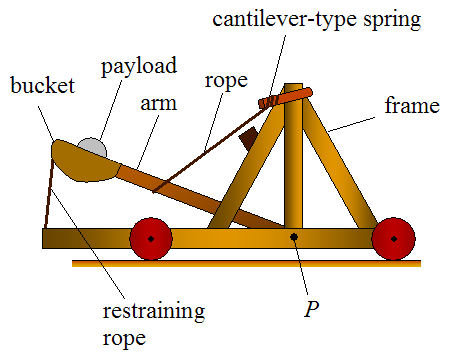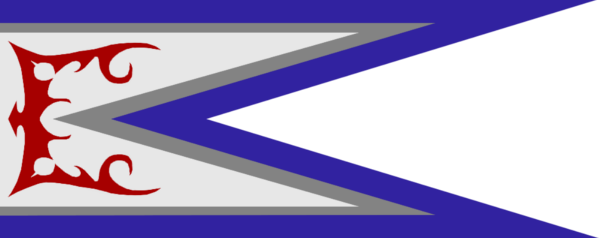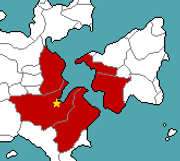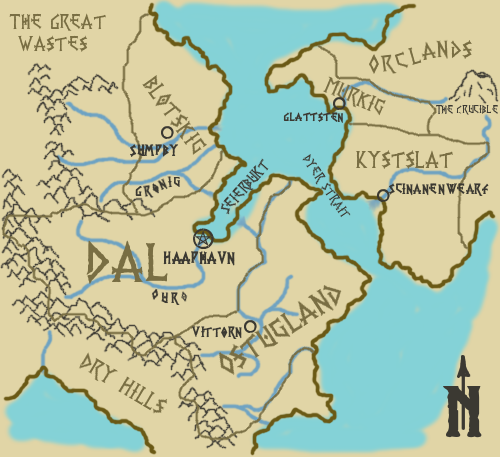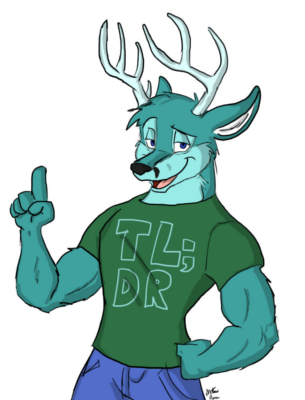Strictly speaking, I'm not sure if "nation" is a valid moniker at this stage.
 Raevyllke
Raevyllke
Located on the southeast tip of Cumhail's largest island, Raevyllke is a well-established monarchy that has ruled the region for roughly two centuries. It is home to a race commonly known as the
varreven, believed to have been transplanted from another world during the Divine War. Varreven are animal in appearance and bear striking similarities to the land's canid fauna, although like the tlaloc and humans their normal posture is bipedal. Varreven are physically strong and agile, making them exceptional fighters, and they are able to recover from more serious injury and illness faster and more extensively than many of their fellow sapients. While not innately tuned to magical auras, ever since arriving in Cumhail the varreven have been unusually sensitive to the so-called divine-level magics; possibly related was the discovery that their characteristics had become transmutable to some other races, resulting in a hybridization dubbed "dualism" by the varreven, "lycanthropy" by the humans.
The varreven race encompasses at least two distinct species with slight differences in physiology. These in turn are divided into numerous social subgroups, dubbed clans. The original clans were believed to have anchored around cosmetic mutations common to a family; these identifiers became codified as clan surnames (Sveret, Sulramsi, Lengktas, etc.) that provide contemporary genealogists a means of tracing ancestral lineage. The nigh-total rewrite of clan territory and population intermixing in the wake of the Unification War means that today the definition of a clan is heavily abstracted, although historic class connotations persist amongst the "old-liners".
History
Clans served as the basis for early varreven society, which for the first hundred years was characterized by internecine tribal rivalries. As indigenous races began to re-establish themselves in the wake of the Clash, clans began to form strategic alliances to better protect themselves, ushering in the first large-scale communities. Less clan-to-clan skirmishes were substituted by larger and more methodic wars between rival pacts and against other races, but the more efficient organization of labour and resources allowed the varreven to steadily expand through the region, and by 224 PC they constituted a majority demographic. This led to "the raevyllke" becoming a popular nickname for the country, and was later adapted as the official title of the kingdom.
The first attempt at banding the clans together under a common leadership was undertaken by Chief Rindalva of the Vitnes clan as a means of driving out the ogres that preyed on inhabitants of the western foothills. Uniting most of the clans of the southwestern valleys, he led a long and bloody war that finally expelled the ogre mage Blutbown in 239, but the alliance unravelled soon after Rindalva's death in 243. Almost immediately afterward, a northern tlaloc warlord named Xepacas, seeking to use his magical advantage to permanently subdue the varreven before they could reorganize again, launched a massive invasion that brought in allies from afar in what became the region's first large-scale war.
As is so often the case, Xepacas' divide-and-conquer gambit proved the catalyst for his foes' unification. The armies swept through the valley, displacing not only the varreven clans, but native communities alike. Unable to retaliate in force, the varreven simply packed up and ran; giddy with momentum, the invaders continued their pursuit deep into the countryside, only to find their supply lines dangerously overstretched. In the winter of 247, the defenders formally joined forces and began a concerted counterattack that slowly drove Xepacas back north. The decisive battle took place in 249 PC at the delta of the River Ouro after a combination of tactical tricks and flanking manoeuvres provoked Xepacas into confronting the coalition's main army with his elite guard. Although equally-matched in numbers, he believed his advantage in magic-users would win the day and did not summon reinforcements before engaging. This turned out to be a fatal mistake when the coalition's mixed units proved more resilient to magic than he had anticipated, due at least in part to the mustering of all their wizards for the occasion. Xepacas was slain, crippling his army's morale; surviving units either retreated home or deserted.
The war had destroyed the political order of the region, and its aftermath saw the varreven emerge as its dominant actors. Seizing on the wartime camaraderie among both the clans and their neighbour races, Chief Frethof of Brunrygg, one of the leading generals in the counter-campaign, motioned for the consolidation of the scattered principalities into a single kingdom. The clans eagerly assented; other races were hesitant to submit to what would clearly be a varreven-controlled polity, but having been crippled by the invasion determined they had little alternative. Frethof was proclaimed King in 250 PC and immediately commenced an ambitious state-building campaign. Sensitive to the complex racial makeup of the region, Frethof invested considerable energy into themes of social unity: Xepacas' invasion was officially chronologized as the "Unification War"; fringe populations, including orcs and trolls, were actively sought out to provide court advisors; and a new capital city named Haaphavn was constructed at the site of Xepacas' final stand, replacing a garuda town destroyed during the campaign.
The state endured, if not without incident. Landholding clans dissatisfied with the ruling monarch made furtive attempts at secession that sparked brief battles throughout the first few decades, and in 319 descendents of Blutbown tried to reconquer their old land, but the incursion, barbaric and disorganized, was easily repelled. Raevyllke was more or less left to grow in peaceful isolation, developing a small but stable economy and establishing centres for the study of science and arcana by its more magically-adept citizens. Largely as a result of lying outside the major shipping lanes, the Raevyllke monarchs never embarked on major frontier expeditions and "overseas" trade consisted mainly of exchanges with a confederacy of independent clans on the eastern island.
The peace was interrupted in 356, when a splinter sect of necromancers operating in the wilderness of the eastern island triggered a major accident that released a throng of ghouls. The island clans, ill-equipped to combat the threat, turned to the king in desperation, promising their fealty in exchange for military assistance. The mainland responded eagerly, dispatching 20 000 troops at first, only to find the horde had nearly destroyed the resident orcs, raising its numbers by several hundred thousand. The onslaught lasted for five years; fortunately for the varreven, whatever had made them transmutable to other races had immunized them against ghoulish infection, and thus their fallen did not deliver a "second blow". The monsters were finally driven out in 361, the orcs eventually hunting them to extinction. The tremendous casualties sustained, worse even than the Unification War, led to widespread demonization of ghouls and similar undead creatures as "evil" and "parasites"; where before their scattered colonies had been avoided and only fought when necessary, extermination campaigns were launched that claim to have eradicated their presence in the kingdom within seven years.
As promised, the island clans joined the kingdom, bringing into its control the port city of Scinanenwearf, which had been a bookend of a sea trade route encompassing most of the southern islands, and as such was a forum for numerous races both local and foreign. Scinanenwearf put Raevyllke on the map, resulting in a growth in merchant trade that funded the rapid expansion of civic institutions and development of other urban centres over the following century.
Economy
Raevyllke's agriculture does not rely on fixed farms, but a combination of forestry and mixed-crop, open-plot plantations that to a stranger is often mistaken for wilderness. The country's expansive forests are managed by large-scale seasonal fires to clear out the underbrush and revitalize the soil, resulting in wide, navigable pathways and towering canopies. The varreven do not domesticate livestock, instead managing herds of wild game in the forests and fallow fields, nor do they appear to keep draft animals. The expulsion of the mountain ogres opened up mining in the west, initially for construction ores but that has since expanded into precious metals. Until the beginning of large urbanization and subsequent emergence of the merchant class in the last two centuries, the economy was chiefly a barter system; the acquisition of Scinanenwearf led to the expanded use of coinage in the cities, but rural trade continues in kind.
The growth of cities and development of civic institutions saw the establishment of schools in science and arcana. Preconceptions about magic carried over from the varreven homeworld, combined with the region's relative isolation, meant the latter developed independent theories that while often proven wrong, did lead to key innovations in the field. Magical adepts, specifically humans and tlaloc, migrated to the cities hosting these schools, and as such urban populations tend to be much more racially integrated than the homogeneously-organized hamlets. The most cosmopolitan city is Scinanenwearf, which had been a major travel and trade hub since at least the Third Century, and whose prestige soared under royal stewardship to become one of the grandest cities in the greater region.
Government
Early Raevyllke monarchies were ostensibly classical absolutist arrangements that rooted their legitimacy in martial merit rather than divine right. Consequently, a ruler was judged by his competence; the clans would make their displeasure with poor performance clear, and traditionally an impugned king would abdicate rather than fight his subjects. Similarly, monarchs were not expected to rule for life (although many did), and would retire if they felt themselves too infirm to continue, or believed one of their heirs would do the better job.
The structure and culture of Raevyllke government received a radical change in 332 under King Vilamir Viradesvans, who delegated royal responsibility by reorganizing the court's previously customary hierarchy into a formal set of offices with defined responsibilities. Counts, who had been little more than sheriffs, were granted greater freedom to dictate policy for their counties without requiring prior assent from the throne. The king also created the office of viceroy, a royal appointee responsible for handling the day-to-day affairs of state on the king's behalf, and who doubled as count of the capital territory (with the option to appoint a viscount if both offices proved overburdening). While the monarch remained sovereign and final arbitrator of all law, in practical terms daily management of the kingdom now resided with the viceroy.
Classical absolutists condemned the action, claiming that delegating royal responsibility proved Vilamir incompetent. Progressives asserted the exact opposite: the old rigid hierarchy required the king to personally confirm each and every law, resulting in top-down management and gross administrative inefficiency; his system would allow greater flexibility (and faster response) to county issues while leaving the monarch to concentrate on the "higher" matters of state. The change was bitterly contested by ambitious courtiers, but the clans welcomed the opportunity for greater self-government, and when the new bureaucracy proved empirically better, resistance evaporated.
While the reforms were not a move toward constitutionalism in any true sense, Vilamir unintentionally depoliticized the monarchy. Applying a meritocratic approach to patronage appointments for his new offices, he frequently sought out the best people for the position regardless of race, rank, or lineage, and in doing so extricated the royalty from formal government charter. To be sure, his own children served in many posts, but royal title was not synonymous with state office: thus Vilamir's eldest son and heir-apparent Gilttop, who spent ten years as deputy to the viceroy in what can be described as political apprenticeship, held the full title Crown Prince (royal), Viscount of Dal (official), while Gilttop's younger sister Torrida held the title Princess (inferior), Countess of Ostugland (superior). Of special note is the viceroyalty, which is customarily given to an individual outside the ruling family.
Today, Raevyllke's government operates on two broad levels with complementary functions. The royalty is responsible for state-level policy, such as organizing wars, launching exploration and trade expeditions, drafting and upholding the law of the realm, and generally planning any large-scale undertaking. While the monarch reserves the right to intervene at the county level, this is very rare and typically done to settle disputes over jurisdiction between lower offices. The viceroy functions as the monarch's deputy, and handles daily affairs that the monarch would otherwise deal with his- or herself, including collection and allocation of taxes, civil and criminal court hearings that are not candidate for capital punishment, and general correspondence with the counties.
Four of Raevyllke's five counties are represented by a royally-appointed count, with the exception of Dal, which answers to the viceroy, or (if one exists) the viscount. Kystslat is unique; due to the history of Scinanenwearf it instead elects a Minister whom the monarch duly approves. The counts were historically charged with enforcing official decrees and collecting taxes; following Vilamir's reforms they enjoy limited autonomy, receiving portions of tax revenue to fund their own projects as well as the right to create county bylaws.
The Royal House
Even before Vilamir's reforms, the concept of dynastic rule was not practised by the varreven with the air of permanence typical of monarchies elsewhere. This may have been due in part to the fluidity of clan leadership prior to unification and the meritocratic nature of its first regional polities. Varreven politics are also virtually devoid of religious connotations; indeed, what little is known of the race's faith is almost purely mystical in nature. The result is that varreven royalty, while considered socially distinct, are treated as statespeople first and foremost, their titles a mark of profession rather than privilege. Clans recognize the monarch as their sovereign, but expect their leader to demonstrate good judgment and stable policy.
Despite clan legacy, the varreven place a surprisingly weak interest in bloodlines at the royal level. This is likely another result of the meritocratic tradition, which regards rigid class hierarchies as artificial and contemptible: marriages for status are scorned as "career-hunting", whereas wedding a commoner with administrative experience is held as a demonstration of prudence. Royal succession is based on longstanding clan inheritance customs, and follows few fixed rules. The monarch is free to select anyone within both immediate and extended family as designated heir, although appointments from the latter are exceptionally rare. If a wedded monarch dies, the crown passes to the spouse ahead of the children; in the event that no heir exists and in lieu of a contingency plan, the viceroy becomes the new monarch.
If the viceroy declines the crown, a council is held and the clans elect a new monarch, usually selecting from the counts as they have proven experience. Bearing this in mind, it is not uncommon for monarchs to forego efforts to secure a dynasty in their lifetime, opting instead to raise their children as robust state servants so that if a new family takes the crown, these children are more likely to be retained, increasing their seniority and thereby their attractiveness to a succession council.
| | King | Queen | | |
| | Torsten Svaltas ( deceased ) | Syfrida Solvpals | | |
| | Children | | | |
| Crown Prince Rasmus | Prince Herlifur | Princess Liffa | Prince Nils | Prince Askill | Princess Karin |
| | | | | |
| | Viceroy | | | |
| | Ranvild Langhogtann | | | |
| Count of Blotskig | Count of Ostugland | Count of Murkig | Minister of Kystslat | |
| Usteynn Roedtas | Prince Herlifur | Rikard Kortnes | Osweald Sigwardsone | |
Name: Raevyllke
Demonym: Raevyllker, vilker (slang); Raevyllking, Raevyllkisk (local tongue)
Primary race: Lycanthrope
Government: Bureaucratized absolutism with a dash of Holy Roman electorate
Monarch: Queen Syfrida Solvpals
Viceroy: Ranvild Langhogtann
Capital city: Haaphavn
Currency: Varies




